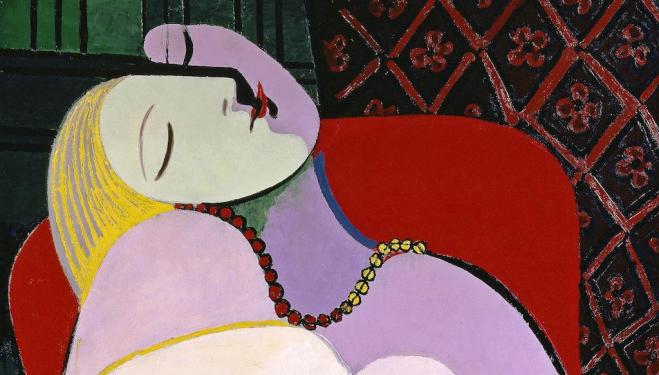Balenciaga: Shaping Fashion at the V&A - an exclusive insight
Closing its doors this weekend, we look back at the most stylish exhibition on now with the V&A's fashion curator, Cassie Davies-Strodder

Decades later, Balenciaga is still renowned for his clarity of vision, impossibly high standards, a first class clientele – Gloria Guinness and Mona von Bismarck were Balenciaga regulars – and a successful career spanning more than half a century. But the V&A's magnanimous exhibition is far from a full-blown retrospective. Instead it focuses on his creative output from the 50s and 60s. 'The most daring and innovative years of his career', Davies-Strodder adds.

Elise Daniels with street performers, suit by Balenciaga, Le Marais, Paris, 1948. Photograph by Richard Avedon © The Richard Avedon Foundation
The entrance to the exhibition is designed to recreate the experience of being fitted by Cristóbal Balanciaga himself. Davies-Strodder explains; ‘we’ve got archive sketches, photographs and footage from one of his early catwalk shows'. Visitors can watch his really unusual models – known at the time as monsters – stomp past on film. 'They were called monsters', Davies-Strodder adds, 'because of their unusual looks. Colette, his favourite model, was rake-thin and described as having ‘jutting hips’. She worked until well into her 50s and walked with a limp by the time she left. He was very avant-garde in that respect'
The two downstairs rooms of the V&A's fashion galleries are garnished with cocoon coats, babydoll dresses and shift dresses drawn predominantly from the museum's own collection of 50s and 60s Balenciaga, assembled by Cecil Beaton in 1972. For Davies-Strodder the highlight piece is undoubtedly Balenciaga’s Envelope Dress. On loan from a private Swiss collection, the four-point dress obliterates any nuance of shapely form. 'With that dress', Davies-Strodder continues, 'Balenciaga strove for complete abstraction, he pushed the boundaries to their limits'.

Alberta Tiburzi in 'envelope' dress by Cristóbal Balenciaga, Harper's Bazaar, June 1967 © Hiro 1967
The looser abstract forms of Balenciaga’s garments of the 50s and 60s transformed the female silhouette in post-war Europe. His revolutionary visions challenged the status quo. Nipped in waists and full skirts propagated by Dior’s 1947 New Look were replaced by empire lines and broad shoulders. While his innovative designs shocked at first, they had a seamless allure. Liberation was at the heart of his craft. The rich and famous came knocking at his door.
But Davies-Strodder is quick to stress that Balenciaga was more than a visionary: he was also an unparalleled craftsman. The 'Balenciaga’s Workrooms' part of the exhibition highlights the designer’s meticulous approach to making – a priority for Davies-Strodder and her team. Collaborations with x-ray artist Nick Veasey and pattern-cutting students from the London College of Fashion permitted the V&A to look beyond the surface texture of his designs. X-rays by Veasey reveal hidden details, structures, weights and boning, all otherwise invisible to the naked eye.

1) X-ray photograph of silk taffeta evening dress by Cristóbal Balenciaga, 1955, Paris, France. X-ray by Nick Veasey, 2016. © Nick Veasey
2) Evening mini-dress, Paco Rabanne, 1967. Museum no. T.165:1 to 3-1983. © Victoria and Albert Museum, London
3) Wild silk evening dress (detail), Cristóbal Balenciaga with embroidery by Lesage, 1960 – 2, Paris, France. Museum no. T.27-1974. © Victoria and Albert Museum, London
The pattern-cutting students made discoveries of their own. They dissected patterns from some of Balenciaga’s most recognised designs, digitalised them, and reconstructed them. 'By doing this', Davies-Strodder says, 'we made one particularly exciting discovery. We’d never really resolved what the ties at the front of the red button back dress were for; they kind of just dangled down at the hem. It didn't matter as we always showed the dress from the back. But one of the students suggested tying the ties around the legs. We later found photographs of other similar dresses with the taffeta tied around the legs. We became quite confident that’s how it should be shown. The dress suddenly made sense'.
On the back of this Davies-Strodder emphasises that 'his extraordinary perfectionism, his vision, his attention to detail were incomparable'. It is little wonder, then, that Christian Dior called him 'the master of us all' and Coco Chanel the ‘only true couturier’ of the twentieth century.
Yet few are the designers today who don’t seek inspiration from Cristóbal Balenciaga. Davies-Strodder lets slip that the Balenciaga archive at the V&A is studied for hours on end by London’s emerging fashion designers, desperate to learn from the master himself. She admits that showcasing Balenciaga’s enduring legacy was imperative to her over-arching vision of the show.

Evening dress, silk taffeta, Cristóbal Balenciaga, Paris, 1955 © Victoria and Albert Museum, London
The final rooms of the exhibition root Balenciaga in the modern day. There is a showcase of work by over 30 designers of the last 50 years indebted to Balenciaga’s vision. Balenciaga-inspired garments by Molly Goddard, Nicholas Ghesquière and Balenciaga’s current Creative Director Demna Gvasalia (voted Business of Fashion's Designer of the Year in 2016) are displayed side-by-side. In this room, Davies-Strodder announces, 'we have drawn parallels between the two (Balenciaga and Gvaslaia) – in terms of their attitude, their reticence to the press, their willingness to question the fashion system, their pioneering attitude'.
With two anniversaries – this exhibition marks the 100th anniversary of the opening of Balenciaga's first fashion house in San Sebastian, and the 80th anniversary of his Paris salon – and a creative director making waves among the international fash-pack, there couldn’t be a better time to stage a Balenciaga showcase. Although a large jazzy theatrical spectacle à la Alexander McQueen is not on the cards, Balenciaga: Shaping Fashion is as glamorous, and intricately detailed as the craftsmanship of the man himself.
Davies-Strodder’s excitement is contagious. Closing this weekend, it is your last chance to see this truly remarkable exhibition.
Tickets are available for £12 and can be booked online here



